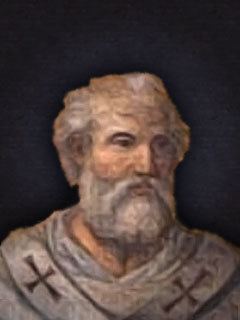Papacy began 25 September 608 Papacy ended 8 May 615 Canonized by Pope Boniface VIII Posthumous style Saint | Name Pope IV Term ended May 8, 615 AD Birth name Bonifacio Successor Pope Adeodatus I | |
 | ||
Died May 8, 615 AD, Rome, Italy Similar People Pope Benedict II, Pope Anastasius I, Pope Celestine I, Pope Pius I, Pope Sixtus I | ||
Pope Boniface IV | Wikipedia audio article
Pope Boniface IV (Latin: Bonifatius IV; d. 8 May 615) was Pope from 25 September 608 to his death in 615. He is venerated as a saint in the Roman Catholic Church with a universal feast falling annually on 25 May.
Contents
Life
Son of Johannes, "a physician, a Marsian from the province and town of Valeria; he succeeded Boniface III after a vacancy of over nine months". He was consecrated on either 25 August (Duchesne) or 15 September (Jaffé) in 608. His death is listed as either 8 May or 25 May 615 by these same two authorities.
In the time of Pope Gregory I, he was a deacon of the Roman Church and held the position of dispensator, that is, the first official in connection with the administration of the patrimonies.
Boniface obtained leave from the Byzantine Emperor Phocas to convert the Pantheon in Rome into a Christian church, and on 13 May 609 (?), the temple erected by Agrippa to Jupiter the Avenger, Venus, and Mars was consecrated by the pope to the Virgin Mary and all the Martyrs. It was the first instance at Rome of the transformation of a pagan temple into a place of Christian worship. Twenty-eight cartloads of sacred bones were said to have been removed from the Catacombs and placed in a porphyry basin beneath the high altar.
During the pontificate of Boniface, Mellitus, the first Bishop of London, went to Rome "to consult the pope on important matters relative to the newly established English Church". While in Rome he assisted at a council then being held concerning certain questions on "the life and monastic peace of monks", and, on his departure, took with him to England the decree of the council together with letters from the pope to Lawrence, Archbishop of Canterbury, and to all the clergy, to King Æthelberht of Kent, and to all the English people "concerning what was to be observed by the Church of England". The decrees of the council now extant are spurious. The letter to Æthelberht is considered spurious by Hefele, questionable by Haddan and Stubbs, and genuine by Jaffé.
Between 612 and 615, the Irish missionary Saint Columban, then living at Bobbio in Italy, was persuaded by Agilulf, King of the Lombards, to address a letter on the condemnation of the "Three Chapters" to Boniface IV. He tells the pope that he is suspect of heresy for accepting the Fifth Ecumenical Council (the Second Council of Constantinople in 553), and exhorts him to summon a council and prove his orthodoxy.
Boniface had converted his own house into a monastery, where he retired and died. He was buried in the portico of St. Peter's Basilica. His remains were three times removed — in the tenth or eleventh century, at the close of the thirteenth under Boniface VIII, and to the new St. Peter's on 21 October 1603.
Boniface IV is commemorated as a saint in the Roman Martyrology on his feast day, 25 May.
